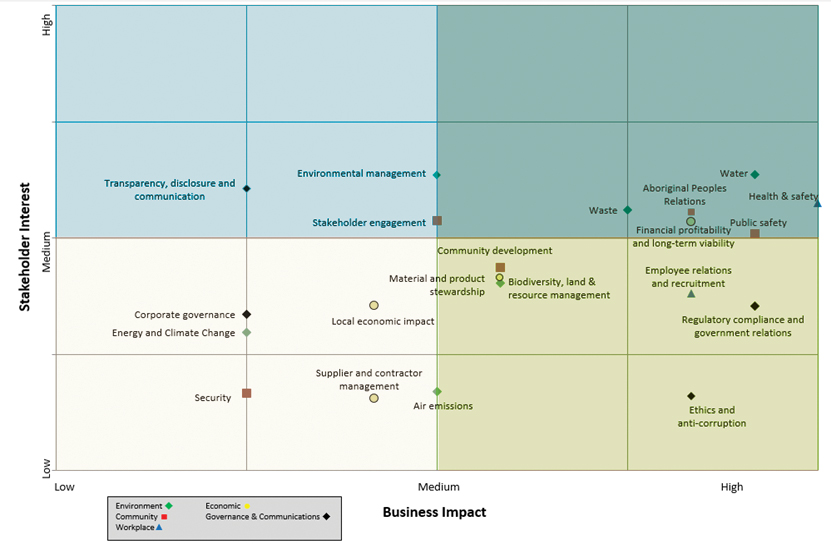What We Measure
We’ve chosen 33 GRI key performance indicators and have kept an additional three corporate indicators because they measure things that aren’t in the GRI framework but are important to our business.
We’ve scrutinized and honed our metrics this year, adding three new GRI indicators to fill important gaps and eliminating two, including one Cameco indicator, that didn’t rank as key issues in our materiality assessment.
| Added | Removed | ||
|---|---|---|---|
| MM1 – Operational Footprint |
|
CA4 – Institutional Shareholder Services (ISS) governance risk indicators |
|
| MM7 – Use of grievance mechanisms |
|
HR11 – Human rights complaints and formal grievances (external) |
|
| MM10 – Operations with preliminary decommissioning plans |
|
||
Materiality Assessment and Matrix
The process in more detail: What we looked at
These are some of the things we considered in identifying our most material issues.
To identify the most important sustainability issues, we considered:
- relevant laws, regulations and standards
- stakeholder expectations and feedback
- internal Cameco guidance, policies and documentation
- leading peer practices and international trends
To determine the interest to stakeholders, we considered:
- stakeholder interview and research results
- media scan trends
- employee questionnaires
- asset manager questionnaires and reports
To determine business impact to Cameco, we considered:
- financial impacts
- operational impacts
- reputational impacts
In 2013, we enlisted the help of Stratos, a Canadian management consulting firm that specializes in sustainability, to help us update our materiality assessment.
The assessment began by identifying the most important sustainability issues to Cameco and our stakeholders. Through the process, Stratos conducted research and interviewed a range of stakeholders, including community members, customers and employees.
Each issue was then analyzed to determine the:
- degree of stakeholder interest, and
- level of expected business impact.
Finally, a team of employees with expertise across the range of sustainability issues and Cameco operations validated the results.
The assessment helped us identify our priority material issues and focus the content of this report.
Our new materiality matrix
The graphic below shows the results of this assessment. Issues which are most important (i.e. those issues which have a high degree of stakeholder interest and a high level of business impact) appear in the upper right quadrant.
The issues that are of medium or high importance or impact for both stakeholders and Cameco are covered in the scope of this report.

GRI Reporting and Measures
GRI is a mature and respected best practice framework, with evolving ties to two other influential bodies that advocate transparent, consistent and comparable reporting, the UN Global Compact (GC) and the International Integrated Reporting Council (IIRC).
GRI reports include meaningful information about the profile of the reporting company, its approach to addressing environmental, social and economic issues, and information about actual performance and trends in six areas:
- economic
- environment
- labour practices and decent work
- human rights
- society
- product responsibility
You’ll find the indicators we use in our GRI index.
Collecting and Verifying Our Data
Cameco has a rigorous system of data collection and validation.
This process begins with assigning an owner to each indicator, who is responsible for compiling and validating the information for this report.
Indicator owners are responsible for both quality control (ensuring the right data is captured, calculated and reported) and quality assurance (ensuring someone else has reviewed and approved the data before it’s submitted). Data is documented using a defined protocol and approved by the department head that oversees the indicator owner’s function.
Where possible, we use data that is captured in our enterprise management system, SAP, and other software and data collection systems, such as Longview and our environmental scorecards.
If indicator data isn’t available for an operation, we identify that in the GRI Index. We have five years of trend information available for most indicators.
The data, information and conclusions contained in this report have been approved by management and the safety, health and environment committee. Representatives from all levels of the company were involved in preparing the information we’ve disclosed.
We’ve also retained Ernst and Young to complete a Limited Assurance review of this report.
GRI Reporting Level
This report is consistent with GRI 3.1 reporting standards and the G3 Mining and Metals Supplement. We’ve included the 3.1 standard disclosures on company profile and management approach in this report, and selected 33 GRI 3.1 and Mining and Metals Supplement indicators to report on.
We are currently reporting at a GRI B+ level.
